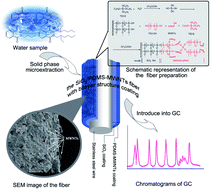Silicon dioxide–poly(dimethylsiloxane) with a bilayer structure, incorporating multi-walled carbon nanotubes, supported on stainless steel wire as a solid-phase microextraction fiber for the determination of trace phthalate esters in drinking water samples
Abstract
Silicon dioxide–poly(dimethylsiloxane) with a bilayer structure, incorporating multi-walled carbon nanotubes, supported on stainless steel wire were prepared by a sol–gel method. This was used as a novel solid-phase microextraction (SPME) fiber in the determination of four phthalate esters (i.e., dimethyl phthalate (DMP), diethyl phthalate (DEP), dibutyl phthalate (DBP), di-2-ethylhexyl phthalate (DEHP)) in drinking water samples. The reaction mechanism of the sol–gel coating process was discussed and confirmed by IR spectra and scanning electron microscopy (SEM). The SPME experimental conditions such as the desorption temperature and time, extraction temperature and time, agitation and the salt effect were optimized. Compared with commercial fibers (polyacrylate (PA), polydimethylsiloxane (PDMS) and divinylbenzene–carboxen–polydimethylsiloxane (DVB–CAR–PDMS)), the novel fiber exhibited better film forming ability, higher thermal stability, higher extraction efficiency, and longer life time. Under the optimized conditions, the detected signals showed good linearity with the concentrations of DMP and DBP in the range from 0.1 to 100 μg L−1, and those of DEP and DEHP from 0.1 to 300 μg L−1. Based on a signal to noise ratio (S/N) of 3, the detection limits of DMP, DEP, DBP and DEHP were estimated to be 0.01, 0.02, 0.01 and 0.02 μg L−1, respectively. All calibration curves were found to have good linearity with the correlation coefficients (r2) which were greater than 0.998. The precision (RSD) of the system, measured by six repeated determinations of the analytes at 10 μg L−1 were in the range of 5.67–12.2%. The recoveries of real samples ranged from 85.27% to 109.3%.


 Please wait while we load your content...
Please wait while we load your content...